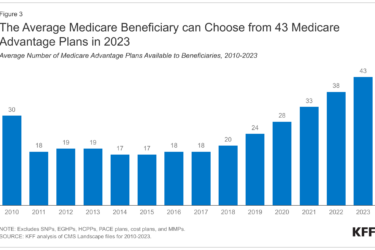Imagine having to pay almost $10,240 for 90 14 mg pills of teriflunomide, a generic prescription drug for patients with multiple sclerosis. Now imagine if the same strength of that 90-pill supply cost only $40.55 at a Wegmans pharmacy, $40.05 at ShopRite, less than $80 at a Walmart or Rite Aid pharmacy and as little as $28.40 at the Mark Cuban Cost Plus Drug Company.
This egregious example of how the U.S. health insurance system drives up prescription drug prices comes from a lawsuit filed Feb. 5 against the pharmaceutical company Johnson & Johnson (J&J) and against J&J’s employee benefits committee.
The lawsuit has nothing to do with J&J’s role as a maker of pharmaceuticals, reporters Bob Herman and Ed Silverman of STAT explained in this story: “A sweeping new lawsuit against J&J asks: Are employers liable if they overpay for drugs.”
Instead, the case focuses on J&J as an employer that buys health benefits and prescription drugs for its workers and their family members. The lawsuit also shows how J&J may be liable for violating the federal Employee Retirement Income Security Act (ERISA) of 1974. ERISA requires employers’ health plans to protect the interests of employees and families enrolled in those plans. J&J has over 100,000 workers worldwide and provides many of them and its retirees in the United States with health care and prescription-drug benefits, the complaint says.
“The case could have sweeping ramifications, potentially opening the doors for any large, self-insured employer to face legal action,” under ERISA, Herman and Silverman reported. And the nation’s largest pharmacy benefit managers and employee-benefits consulting firms that employers pay to manage health and drug benefits could be named in similar lawsuits, experts told Herman and Silverman.
The power of journalism
This case is important for health care reporters for many reasons. First, the lawsuit highlights the power of journalism because it includes multiple mentions of a 4,000-word STAT investigation that Herman wrote in June. In that article, Herman explained that the nation’s largest employers pay consulting firms to get the best deals possible from PBMs and to ensure that these middlemen are not ripping them off with unfair contracts.
“But a largely hidden flow of money between major consulting conglomerates and PBMs compromises that relationship, a STAT investigation shows,” Herman wrote. “Some consulting firms often are getting paid more — a lot more — by the PBMs and health insurance carriers that they are supposed to scrutinize than by companies they are supposed to be looking out for.”
In that same article, Herman explained that the United States spent over $633 billion on prescription drugs in 2022, adding that the conflicts of interest he cited cause employers to spend unknown billions of dollars for employee benefit consultants and PBMs, he added.
Second, the lawsuit alleges that by mismanaging J&J’s prescription drug program, the defendants cost the company’s benefit plans and its employees millions in higher payments for prescription drugs, higher premiums, higher deductibles, higher coinsurance, higher copays, and resulted in lower wages or limited wage growth.
When employers pay more for health care and pharmacy benefits, workers’ take-home pay declines and job losses ensue, as Zack Cooper, Ph.D., an associate professor of public health and of economics at Yale University, testified in June to the U.S. Senate Finance Committee.
In January, Caitlin Owens at Axios reported on a study in JAMA Network Open that showed how the rising cost of health insurance premiums has led to wage stagnation. “Families with workplace health insurance may have missed out on $125,000 in earnings over the past three decades as a result of rising premiums eating into their pay, according to a new JAMA Network Open study,” Owens wrote.
See this Data Deep Dive for more on how high and rising health insurance costs lead to lower wages and increased disparities.
The question of employers’ liability
The lawsuit was filed in the U.S. District Court in New Jersey on behalf of the plaintiff, Ann Lewandowski, a J&J employee working as a health policy and advocacy director on leave due to a dispute regarding a reasonable accommodation for a medical condition, the complaint explains. Specifically, the lawsuit charges that J&J and its benefits committee mismanaged the prescription-drug benefits provided to J&J workers and violated the fiduciary responsibilities employers have to workers.
Under ERISA, employers have a fiduciary responsibility to manage benefits plans solely in the interest of workers and family members, the U.S. Department of Labor says. The lawsuit against J&J and its benefits committee is the first to involve plan members suing their employer for breach of fiduciary duty, according to a benefit consultant Herman and Silverman quoted.
Reporting on the J&J lawsuit for The Wall Street Journal, Melanie Evans and Anna Wilde Mathews quoted Elizabeth Mitchell, chief executive of the Purchaser Business Group on Health (PBGH), in San Francisco, a coalition of employers. “This is the first suit of its kind that we’re aware of,” Mitchell said. “It definitely will not be the last.” For the past year or so, PBGH has been offered educational sessions to its employer members to explain the potential legal liability involved in providing health and drug benefits to workers, Mitchell added.
J&J didn’t do enough to get a good deal on prescription drugs, and the employees overpaid for some generic drugs designated as specialty medications by millions of dollars, Evans and Mathews reported. “The lawsuit asks J&J to make good on losses to the employees’ health plan from alleged mismanagement, but doesn’t stipulate a sum,” they wrote.
Most employers contract with PBMs
Like J&J, most U.S. employers contract with PBMs to manage workers’ prescription drug benefits, a practice health policy experts, lawmakers and others believe is partly responsible for the nation’s high drug prices, Herman and Silverman reported.
The lawsuit alleges that J&J contracts with Express Scripts, the PBM division of the health insurer Cigna, and with the benefits consulting company Aon. J&J allowed its selection of a PBM “to be guided or managed by a broker with a potential conflict of interest,” the lawsuit adds.
An analysis of the prices that J&J and the benefits committee agreed to reveals “a staggering markup from prices charged to comparable plans by other traditional PBMs,” the lawsuit says. Such high prices “exceed the prices that any prudent fiduciary would agree to pay,” it adds.
Employee benefits consultants sometimes require PBMs to pay anywhere from $1 to $5 for every prescription that an employee, family member or retiree fills under an employer’s contract, Herman and Silverman reported. In exchange, the consultants will recommend the employer choose that PBM, a fact that may not be disclosed to the employer, they added. “Because it receives payment, the consulting firm also may not closely scrutinize the PBM contract, which allows the PBM to profit more on certain drugs,” they wrote.
Reporting resources
- “Fed up with exorbitant health costs, employers and workers are taking insurers to court,” STAT News, June 12, 2023.
- “Untangling the Shifty Deals That Pad Pharma Prices,” Freakonomics podcast interview with Bob Herman, Sept. 24, 2023.
- Osceola schools settle lawsuit over insurance consultant’s ‘secret commissions,’ Florida Politics, Feb. 17, 2023.
- “National trends in prescription drug expenditures and projections for 2023,” American Journal of Health System Pharmacy, July 2023.
- “The Drug Rebate Curtain,” Axios, April 2, 2018
- 4 Steps for Large Employers to Meet Fiduciary Duties and Mitigate Legal Risk, Purchaser Business Group on Health (PBGH), San Francisco, Newsroom.
- Employers’ Prescription for Affordable Drugs, PBGH, San Francisco
- ERISA Industry Committee, Washington, D.C.
- National Alliance of Healthcare Purchaser Coalitions, Washington, D.C.









